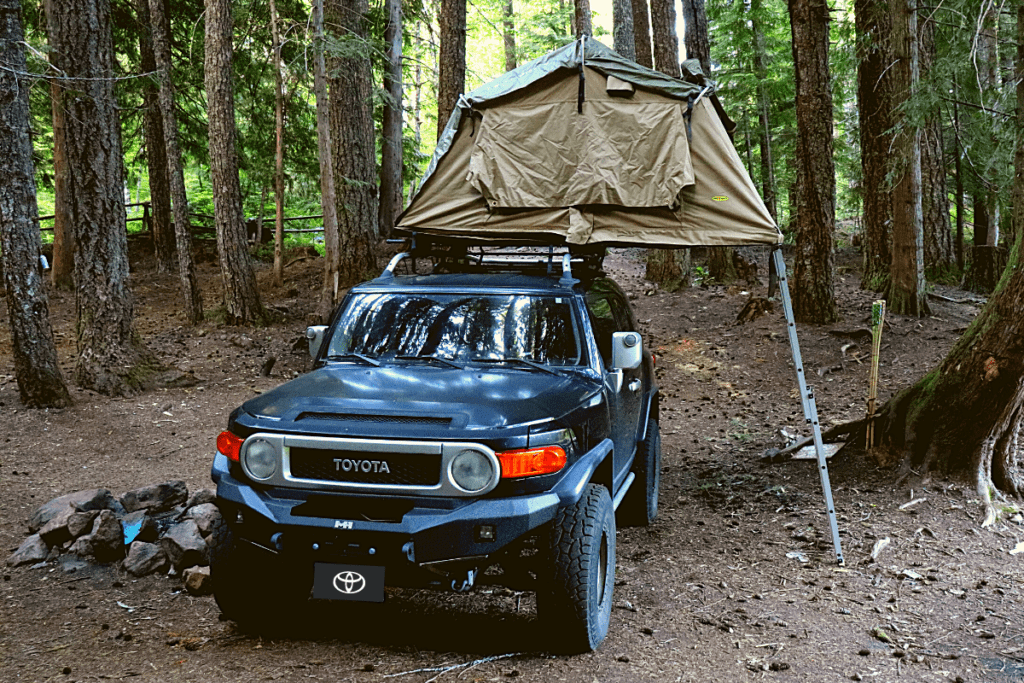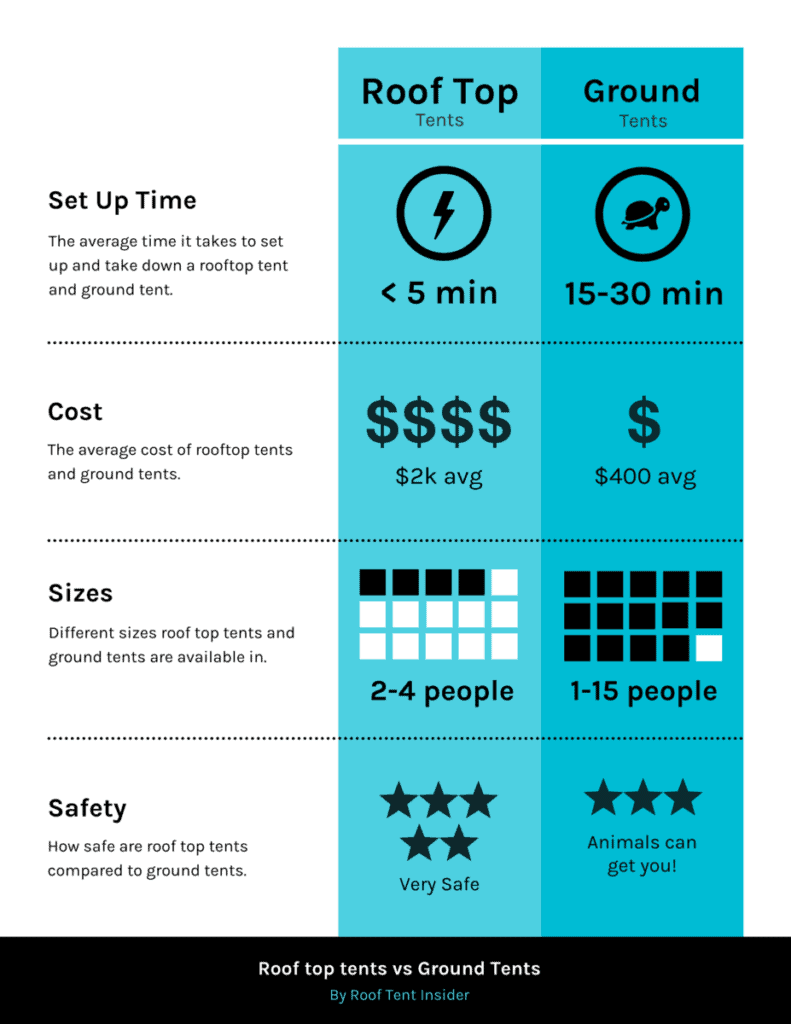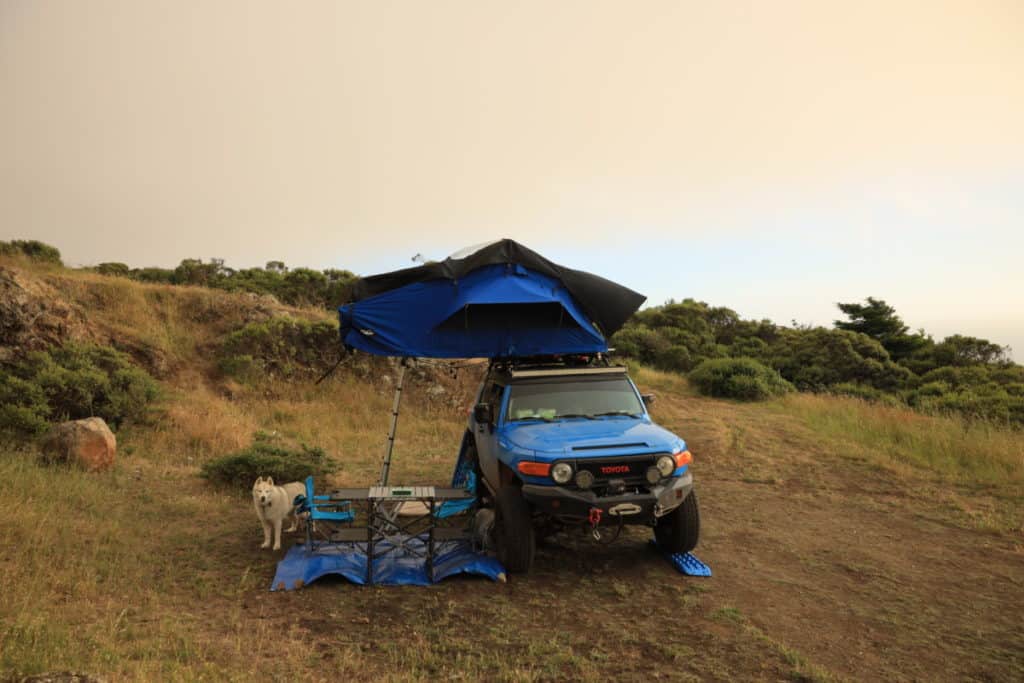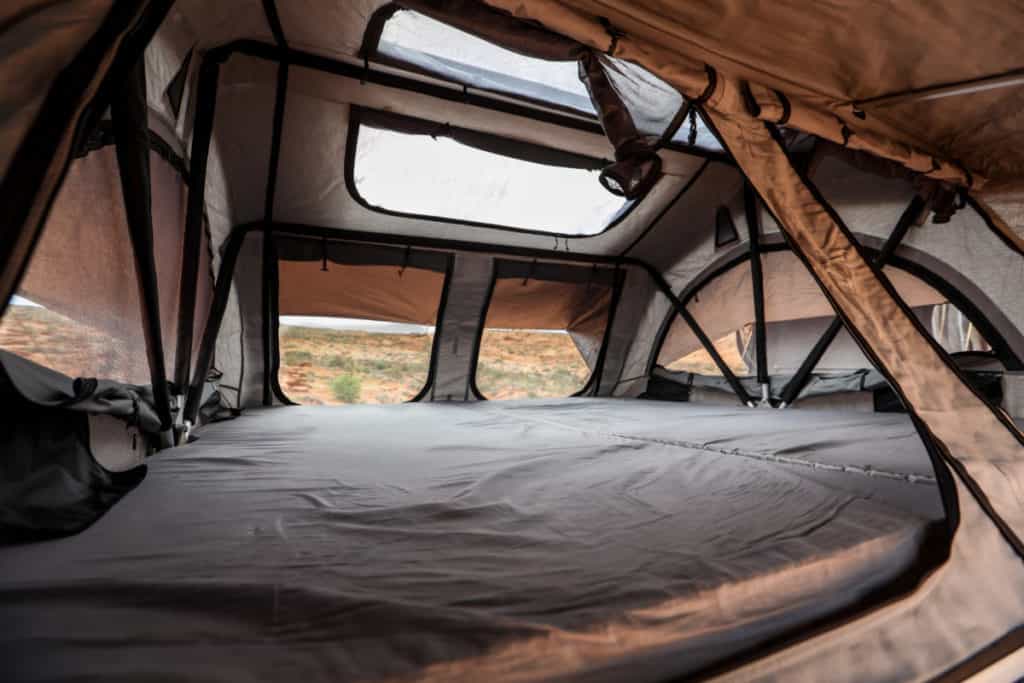
For many campers that have seen, but never owned a roof top tent, you may be wondering which option is best. Well, to reach a conclusion there are many factors you need to consider.
The biggest difference between a ground tent and a roof top tent is the added comfort, convenience, cleanliness, and safety that it provides.
Each individual will find some factors to be more important than others. To help highlight the major differences and benefits between a roof top tent (RTT) and a ground tent, I will speak on my experiences using each throughout my year’s camping.
What are the Differences Between a roof top tent and Ground Tent?
As someone who has camped using both an RTT and a ground tent, I see the pros and cons of each. This article will serve as my unbiased recommendation for each style of tent.
1. Setting Up Roof Top Tents is Faster

The process of setting up and breaking down camp can be tedious at times. I think many campers care a lot about the ease and speed with which they can do this repeatedly.
I would say that the average ground tent takes 5-10 minutes to set up if not more, and that’s not including the time to blow up a mattress or make the bedding for your sleeping arrangement. The process to break down the tent will take even longer.
Using stakes, tarps, and tie-downs is a complete pain in the butt. I know there are some outliers for ground tents where you can essentially have them pop up in a matter of seconds, but generally speaking, this is where I feel the RTT has an upper hand.
Depending on the model of RTT you buy, a hardshell that is assisted by gas struts can be opened and closed in less than 60 seconds, with the bedding already inside!
A foldout softshell RTT takes a bit longer, maybe five minutes since there are more steps involved in setting up the tent. Either way, in my mind RTTs have the edge over ground tents in the ease to set them up.
2. More Safety and Cleanliness in a Roof Top Tent
RTTs have been popular in areas of the world like Australia and Africa for many decades. Having a tent that is off the ground when everything around you is trying to kill you will provide huge amounts of peace of mind!
When camping in a RTT you don’t need to worry about creepy crawlies getting in your tent or bothering you as you sleep.
Ground tents need to have a nice flat area to be cleared out as a campsite. If it is wet or muddy the area will be virtually unusable. RTTs allow you to camp anywhere your car can take you, which is great but has its downsides too!
If you find an awesome space to set up camp but can’t get your vehicle to the spot, you’re out of luck. Whereas a ground tent can be hiked and placed anywhere you see fit!
3. Being Able to Leave the Campsite Conveniently
We’ve all been in a situation where we have searched for hours to find the perfect campsite! After much exploring and patience, finally reaching your destination can be a huge relief to a lot of people.

Unfortunately for RTT users, if you want to drive around and explore, you run the risk of losing your campsite. For a real-world example, let’s say you’re going fishing at the lake just a few miles down the road. You’re going to have to pack up your tent and gear and leave the campsite altogether!
If you had a ground tent in this scenario, you could just pack up some of your expensive gear but leave the tent and camping chairs which will “reserve” your coveted camping location.
So, if you’re one to leave your campsite frequently to explore or do other fun activities, keep this in mind when debating between the two sleeping options!
4. Roof Top Tents are Expensive
You can find some really high-end ground tents that cost a lot of money. For the most part, getting a decent one for roughly $100 is very doable. $100 towards a RTT will barely buy you the ladder!
The cost of a RTT may give many people pause before buying. The cheapest you can snag a brand new one up for is roughly $1,000 and they can easily climb into the $4,000 price range.
If you want to learn more about How Much A Roof Top Tent Costs, check out this article! I give around 40 examples of the most popular RTT prices as well as a video with some unexpected associated costs you can expect to have when buying one.
Like many other things, you get what you pay for! If treated and maintained correctly, a RTT can last you years and even over a decade in some cases. The fabric on roof tents is extremely thick and typically made of heavy-duty materials.
For a casual camper, spending thousands of dollars on a RTT may be hard to justify and I could see why.
5. Roof Top Tents Offer More Comfort
Having slept many nights in both a ground tent and a roof top tent, it isn’t even close which I prefer!
A RTT offers a thick mattress pad that will be 2-3.5 inches thick, but more than anything the perfectly flat surface makes sleeping through the night so much easier!

You do have to spend some time leveling your vehicle if it is on an uneven surface which you can do using recovery boards, rocks, or 2 x 4’s. But it still beats having to clear a campground from rocks and branches only to have it be a bumpy uneven surface.
You could get a really nice mattress pad for your ground tent which makes it a lot better, but it’s still not close to a RTT in terms of comfort. You can even add a 2″ thick mattress pad on top of your RTTs mattress if you want maximum comfort!
7. Ground Tents are Bigger than Roof Top Tents
The amount of people you can sleep inside a ground tent is far better than any roof top tent you will find. For RTT’s, fitting four people comfortably is about as good as it gets!
If you’re camping with a large party or simply enjoy having extra room in the tent, a ground tent would be a better fit for this scenario!

The Largest Roof Top Tents can fit up to 5 people inside. It would also be configured as 2 adults and three children. However, one surefire way to increase the living space for a RTT is to add an annex.
Many tent manufacturers offer them bought separately and some even package them together! An annex sits underneath your tent and depending on the RTT can enclose the ladder as well. Some are massive and you could fit another 3-5 people in the annex alone!
Sure, they won’t get the added comfort from the RTT, but it is a way to camp in a large party nonetheless.
9. Bedding Stores Inside the Roof Top Tent
One thing I love about my RTT is not having to worry about packing a tent, bedding, and mattress pad inside my vehicle. As you know, once you pack up the car to go camping it fills up very fast. If you’re like me, the car is left with little room for extra gear.
Having the RTT stored on top of the roof makes it so much easier and in a sense allows you to pack “light”. In a funny way, this is also counterintuitive because RTTs weigh anywhere from 100-200 pounds. Click here for a complete RTT Weight Guide which lists over 30 examples in an easy-to-read table.
Naturally, adding the weight and size of the RTT to the roof of your vehicle will have an adverse effect on the gas mileage you can get. In my experience, it doesn’t change how the vehicle handles all that much, you just notice the extra weight it bares.
To close this point with a pro for ground tents, they are insanely lightweight. You can easily throw it in the back of the vehicle when you leave for your adventure and it’s that simple!
10. Getting In and Out of the Tent
So, let’s talk about getting in and out of a RTT. To put it lightly, it isn’t the most fun thing to do and I try to limit my trips up and down the ladder.
This is especially true if you have a dog that can make this process extremely difficult and downright undoable for some. Another gripe I have is when you need to use the restroom, climbing down a ladder in the pitch-black will test your skills!
This isn’t news to you but you can walk right into a ground tent and usually walk around without having to hunch over too much. With RTTs, there is no walking around about the tent and you kind of have to crawl around inside.
11. You Need a Proper Vehicle and Roof Rack System for Roof Top Tents
If you really wanted to, you can put a RTT on a Prius. It isn’t recommended, but adding a proper roof rack on that vehicle and getting a very light and very small RTT can make it possible.
This wouldn’t be ideal for obvious reasons. So another factor I would like to bring up is having the need for a proper vehicle, preferably one with four-wheel drive.
This is important because you are relying on your vehicle to get you to your camping destinations and don’t want to be held back by the limits of your vehicle.
In addition to that, the bigger the car, the bigger the RTT you can upgrade to! Full-sized SUVs and trucks will have their pick of any tent size. Whereas a compact SUV or sedan will be limited.

Last but not least, you need a crossbar system or permanent rack for your RTT to be mounted on. We won’t get too much into this now, but if you want to learn more about the topic read this article on Choosing A Rack System For Your RTT. I highlight plenty of examples and best practices when searching for the perfect rack!
Obviously, none of these extra expenses or considerations need to be made when purchasing a ground tent. If you’re a prospective buyer of a RTT reading these articles will save you hours of research, but either way, it takes research to learn all of the best practices.
Which is better?
Like I said from the start, it depends on what you need from a tent. If you’re comfortable with the cost of a RTT and some of the hindrances that come with it, then I know you will love it!
I also see the argument to keep a ground tent, especially for a casual camper. The cost, size, and other inconveniences it can bring at times may not be worth it for some people.
I would say more people than not love their RTT purchase, those who are not satisfied are usually the ones that only got a couple of camping trips out of it. In a worst-case scenario, you can always sell the RTT at a decent value compared to what you bought it at.
Wrapping Up
To conclude this article I wanted to reiterate that I don’t have a horse in this race. Whether you choose to use a ground tent or roof top tent makes no difference to me!
However, I did think this would be a very useful bit of information for someone who is curious or really considering making the change! It is a common question I get from friends and not a cheap decision to make.
In the end, it’s just money. One thing a RTT has done is force me to get out and camp, in a good way! I feel obligated to get the money out of it so I spend more nights in the mountains and days by a lake. This has been one unexpected perk of buying a RTT.
I hope you found this to be helpful, unbiased, and fun to read. If you want to check out our recommended gear page or other articles, simply browse our website by using the menu.
